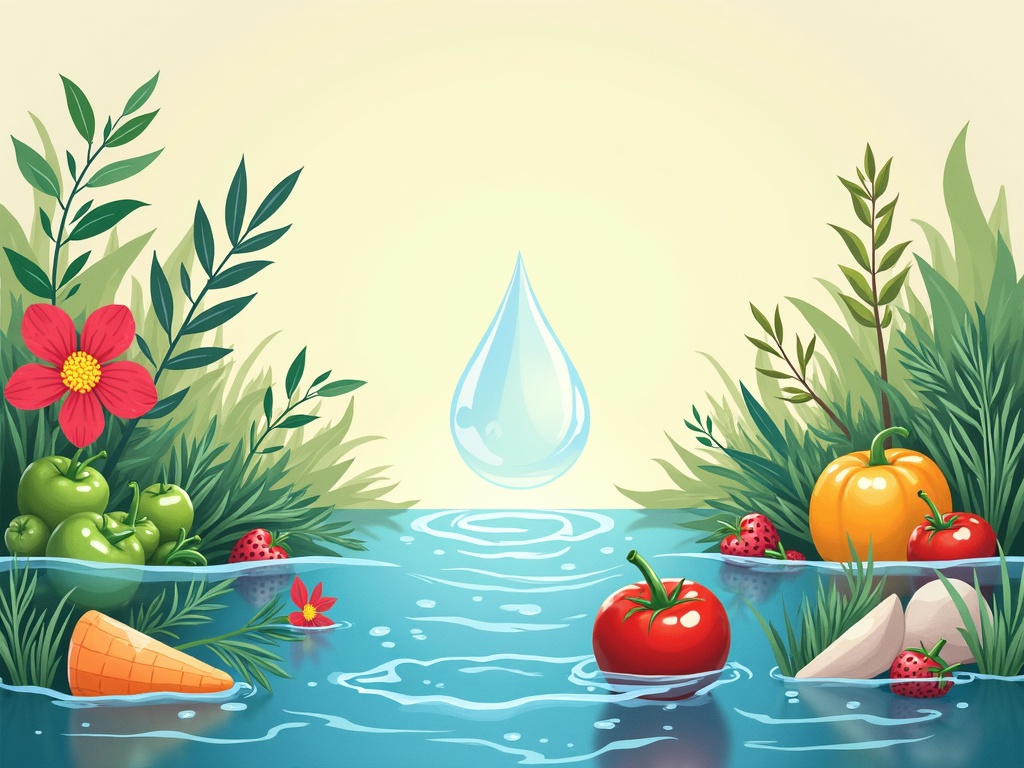The Connection Between Diet and Water Usage: Eating for a Thirsty Planet
Did you ever stop to consider that your food choices have a significant impact on global water resources? We often hear about saving water by taking shorter showers or turning off the tap while brushing our teeth. While these habits are important, the water footprint of our diet often dwarfs the water we use directly in our homes. This article dives deep into the fascinating – and often alarming – connection between diet and water usage, exploring how different food choices affect water consumption and offering sustainable eating strategies for a thirsty planet.
Understanding Water Footprints: More Than Meets the Eye
We all know water is essential for life. But the amount of water required to produce the food we eat varies dramatically. A food’s water footprint encompasses all the water used to grow, process, transport, and ultimately prepare that food for consumption. This includes rainfall, irrigation, and water used for cleaning, cooling, and manufacturing.
Think about a juicy steak versus a bowl of lentils. The steak requires water to grow feed for the cattle, water for the animals to drink, and water for processing at the slaughterhouse. Lentils, on the other hand, require only water to grow the crop. This difference in water intensity creates a substantial discrepancy in their respective water footprints.
Virtual Water: The Hidden Water in Our Food
The concept of virtual water helps us understand the hidden water embedded in our food. Virtual water refers to the amount of water used to produce a product, even if that water isn’t directly visible. For example, a single cup of coffee requires approximately 140 liters of water to grow, process, and package the beans! Understanding virtual water helps us appreciate the true water cost of our dietary choices.
The Biggest Culprits: Foods with High Water Footprints
Certain food categories are notorious for their high water footprints. Becoming aware of these culprits is the first step toward making more water-conscious dietary choices.
**Meat (especially beef):Beef production is by far the most water-intensive food production system. Raising cattle requires vast amounts of water for feed production (primarily grains and soy), drinking water for the animals, and sanitation.
**Dairy Products:Similar to beef, dairy production relies on water-intensive feed crops and the maintenance of dairy cows.
**Nuts (especially almonds):While nuts are generally a healthy snack, some varieties, particularly almonds, require significant irrigation, especially in regions prone to drought.
**Certain Fruits and Vegetables:Some fruits and vegetables, like avocados and asparagus, have relatively high water footprints compared to other produce. This is often due to their growing conditions or specific agricultural practices.
The Water-Saving Heroes: Foods with Low Water Footprints
Fortunately, many delicious and nutritious foods have relatively low water footprints. Incorporating more of these into your diet can make a significant difference in reducing your personal water consumption.
**Legumes (beans, lentils, peas):Legumes are nutritional powerhouses that require significantly less water than animal products. They are also nitrogen-fixing crops, enriching the soil and reducing the need for fertilizers.
**Grains (wheat, rice, corn):While rice can be water-intensive depending on the cultivation method, grains, in general, have a lower water footprint than meat and dairy. Opt for sustainably grown grains to minimize your impact.
**Most Fruits and Vegetables:The majority of fruits and vegetables have lower water footprints than animal products. Prioritize locally sourced, seasonal produce to further reduce your water footprint.
Specific Examples: Comparing Water Footprints
To illustrate the stark differences in water footprints, let’s look at some specific examples:
**1 kg of beef:Approximately 15,400 liters of water
**1 kg of pork:Approximately 6,000 liters of water
**1 kg of chicken:Approximately 4,300 liters of water
**1 kg of lentils:Approximately 1,250 liters of water
**1 kg of potatoes:Approximately 290 liters of water
These figures highlight the substantial water savings possible by choosing plant-based protein sources over meat.
Sustainable Eating Strategies: Reducing Your Water Footprint
Making conscious dietary choices can significantly reduce your water footprint without sacrificing flavor or nutrition. Here are some practical strategies:
1. **Reduce Meat Consumption:This is arguably the single most impactful step you can take. Start by incorporating more meatless meals into your week.
2. **Choose Plant-Based Proteins:Replace meat with legumes, tofu, tempeh, and other plant-based protein sources. These options are not only water-efficient but also packed with nutrients.
3. **Opt for Sustainable Seafood:If you consume seafood, choose sustainably sourced options to minimize the environmental impact. Look for certifications like the Marine Stewardship Council (MSC).
4. **Eat Seasonally and Locally:Locally sourced, seasonal produce requires less transportation and often utilizes more sustainable farming practices.
5. **Reduce Food Waste:Food waste represents a significant waste of water. Plan your meals carefully, store food properly, and compost leftovers to minimize waste.
6. **Choose Water-Efficient Crops:Opt for fruits and vegetables with lower water footprints, such as berries, melons, and leafy greens.
7. **Be Mindful of Processed Foods:Processed foods often require more water for manufacturing and packaging. Choose whole, unprocessed foods whenever possible.
8. **Support Sustainable Agriculture:Support farmers and ranchers who employ sustainable water management practices, such as rainwater harvesting and efficient irrigation techniques.
9. **Consider a Plant-Forward Diet**: This diet focuses on vegetables, fruits, whole grains, legumes, nuts and seeds, while still allowing for moderate consumption of animal products.
Beyond Individual Choices: Systemic Changes for Water Sustainability
While individual dietary choices play a crucial role, addressing the connection between diet and water usage requires systemic changes at the agricultural and policy levels.
**Investing in Water-Efficient Irrigation:Implementing efficient irrigation technologies, such as drip irrigation and micro-sprinklers, can significantly reduce water waste in agriculture.
**Promoting Sustainable Farming Practices:Encouraging farmers to adopt sustainable farming practices, such as crop rotation, cover cropping, and no-till farming, can improve soil health and reduce water consumption.
**Developing Drought-Resistant Crops:Investing in research and development of drought-resistant crop varieties can help ensure food security in water-scarce regions.
**Implementing Water Pricing Policies:Implementing water pricing policies that reflect the true cost of water can incentivize water conservation in agriculture and other sectors.
**Raising Consumer Awareness:Educating consumers about the water footprint of their food choices can empower them to make more informed and sustainable decisions.
The Future of Food: Eating for a Water-Secure World
As the global population continues to grow, and climate change intensifies water scarcity, rethinking our relationship with food and water is essential. By adopting more water-conscious dietary choices and supporting sustainable agricultural practices, we can contribute to a more water-secure future for ourselves and generations to come. The connection between diet and water usage is undeniable, meaning every bite we take has the power to either deplete or conserve our planet’s most precious resource. Let’s choose wisely.

